Animals of Tasmania
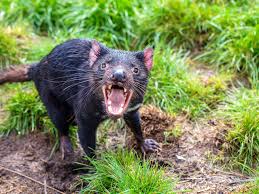
Animals of Tasmania
Posted on
There are many reasons why Tasmania stands alone as the hiking Mecca of Australia. With about 20% of the state reserved as a world heritage listed wilderness area, it contains some of the most pristine and unique landscape in the country for which to hit the trails. One of the greatest draws of hiking amongst that unique landscape, is the variety of crazy critters that can be encountered which are found nowhere else on the planet. Having become isolated from mainland Australia around 12,000 years ago during the melt of the last ice-age, Tasmania’s wildlife have survived on the island where in other parts of the country they have perished.
So with that in mind, let’s get to know a few of the locals that you might encounter on the apple isle.
Tasmanian Devil
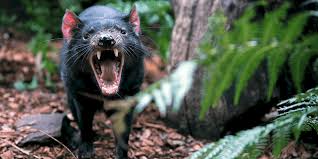
The first animal that springs to most people’s mind when they think about Tasmania’s wildlife is the iconic Tasmanian Devil. It’s chilling scream, feisty attitude and ferocity when feeding have set this little creature apart from all other animals in Australia.
The Tassie Devil once inhabited mainland Australia, it is believed that they became extinct there around 3000 years ago, well before European settlement. This was most likely due to increasing aridity and the growing population of dingos. Of course Tasmania remained wetter than most of Australia and the formation of Bass Strait kept the dingos confined to the mainland so it is here where devil’s continued to roam.
Unfortunately the poor old devil’s were considered a nuisance by early European settlers of Hobart, as they were thought to have feasted on the poultry farmers produce. In fact in 1830 a bounty scheme was introduced to exterminate devils, as well as Tasmanian tigers and wild dogs from their properties. Around 25 cents was given for male devils and about 35 cents for females.
The trapping and poisoning of devils continued for a century until they became increasingly rare. Luckily sense prevailed before it was too late and they were given protection in 1941, which saw their numbers gradually increase.
The devil’s next main threat for survival was realised in 1996 when the Devil Facial Tumour Disease (DFTD) was discovered. This crippling disease has ravaged Tasmania’s wild devil numbers, with estimates of between 20% to as much as 80% of the population being affected. The disease kills the animal within months and is still the major threat to the survival of the species today. Luckily there have been some wonderful efforts in trying to salvage the species by the creation of an ‘insurance population’. This has involved moving disease free devils to Maria Island where they can live in the wild, breed and eventually be repopulated to the mainland of Tassie. So far it has been successful with a starting population of 28 in 2012, growing to around 90 today. Fingers crossed this initiative continues to work!
So what else makes this animal so special? Well, it’s the world’s largest carnivorous marsupial and can grow to about 12kg. Their typical lifespan in the wild is around 6 years and they like to live in a variety of landscapes including coastal heath, open dry sclerophyll forest, and mixed sclerophyll-rainforest.
Devil’s will eat all and everything! They are both scavengers and hunters and when they eat, they consume all. Their powerful jaws totally devour their prey, bones, fur and all! Favourites are small wallabies, possums and wombats, plus a variety of birds, reptiles and other small mammals. They are also great for keeping the flies away, as they love to consume sheep and cattle carcasses from pastoral properties.
Of course the Tasmanian Devil was given it’s name for a reason. Besides it’s terrifying screech, red ears and sharp teeth, the devil also has a famous gape or yawn that would give a child nightmares. This seemingly ferocious display is not what it seems though and comes from fear and uncertainty rather than from aggression. If a devil wants to fight, it typically makes a sharp sneezing noise as a warning to it’s opponent. A lot of the other snarls and screeches are more a bluff than anything else and part of a ritual to minimise any brawling when feeding with their friends.
So if you’re hiking in Tasmania and you hear a screech that puts a chill through your spine, never fear, it may be your chance to see one of the most iconic animals in Australia whilst you still can.
Eastern Quoll
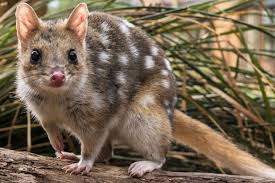
Quolls are super cool little critters that are in the same family of carnivorous marsupials as the Tasmanian Devil. Sometimes referred to as native cats, these guys are another prized sighting if you happen to see one in the wild. (Guides Campbell and Simon once saw one while walking back to their accommodation from the restaurant in Lake St Claire …we still hear about)
Like the Tassie Devil, the Eastern Quoll was once found on the mainland of Australia but hasn’t been seen there since the early 1960s so is thought to have become extinct. There have been reported sightings in the New England region of NSW recently so there is a glimmer of hope that they still survive there.
The Eastern Quoll is about the size of a small domestic cat and is considerably smaller than it’s relative, the Spotted Tail Quoll. Typically solitary animals, they are nocturnal hunters and scavengers. They mostly eat insects but are also impressive hunters and can take down rabbits, rats and mice by killing them with a bite on or behind the head.
The main threat to Eastern Quolls these days are feral cats. Not only do they compete for the same food, feral cats can quite comfortably take down an Eastern Quoll for dinner too. Add foxes, dogs and road kill to the mix and the Eastern Quoll has a battle on it’s hands for survival. Fortunately Eastern Quolls are a totally protected species by law.
Spotted Tail Quoll
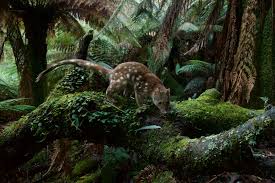
Our other type of quoll found in Tasmania is the Spotted Tail Quoll. Significantly larger than the Eastern Quoll, this guy is the second largest surviving carnivorous marsupial behind the Tassie Devil. With a large male weighing up to around 4kg, this quoll was sometimes called the ‘Tiger Cat’ which doesn’t really make sense because it is covered in large spots not stripes!
Once prevalent on the east coast of mainland Australia, Spotted Tail Quolls are now pretty rare in that neck of the woods. They are typically found in cool temperate rainforest, wet sclerophyll forest and coastal scrub along the north and west coasts of the state.
Being significantly larger than the Eastern Quoll, the Spotted Tail Quoll likes to eat slightly bigger things like rats, possums and even small wallabies. The larger animals have a feisty competitor for the food though, the Tasmanian Devil. They don’t go down without a fight though, a large female was once spotted chasing a Tassie Devil away from a carcass!
Spotted Tail Quolls face similar threats as the Eastern Quoll, and are also fully protected by law so hopefully their numbers remain intact and a fortunate encounter with one in the wild remains a possibility.
Pademelon
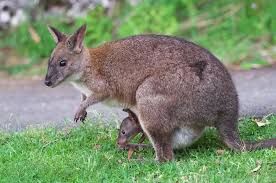
Yes that’s right, they are called Pademelons. And before you start wondering if you’ve seen them in the fruit section of the supermarket, they are another one of Tasmania’s unique creatures.
More specifically known as a Rufous Bellied Pademelon, the first time I saw one, I swore it was a quokka. The big difference was there were no people around trying to get a selfie with it! The other main difference to the eye was that it was considerably larger than a quokka, with a large male weighing up to around 12kg. The females are more like a typical quokka size, around 4kg.
The name Pademelon is actually a derivation of it’s Indigenous name and they are a member of the macropod family, the same as kangaroos and wallabies.
Once again a victim of predation and loss of habitat on mainland Australia, Pademelon’s are now restricted to Tasmania. They are however widespread and abundant throughout the state and are a common site in the vegetation of national parks.
Eating mostly grasses and herbs, Pademelons are a favourite meal for Tassie Devils and Quolls, and were once an important source of food for the now extinct Thylacine. They are also sometimes considered a pest by farmers as they like to feed on crops in the farming regions. In fact, hunting of Pademelons is allowed with a license, its fur is quite valuable and the meat also available for consumption.
I don’t think I could ever eat an animal as cute as this though!
Eastern Bettong
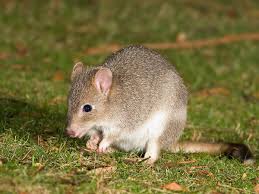
Another cute little creature that is only found in Tasmania is the Eastern Bettong. Known as the Balbo to the Ngunnawal People, this little marsupial only grows to about 2kg and can only be found in the eastern part of the State.
Becoming extinct on the mainland in the 1920s, a small population of the Eastern Bettong was reintroduced near Canberra in 2017. Initially deemed an incredible success with the first mainland birth in the wild for 100 years, unfortunately the success was short lived as all 67 animals and their young have since perished. Each death was the result of foxes.
In Tassie, the bettong likes to live in dry open eucalypt forests and grassy woodlands. It’s days are spent in a camouflaged nest of grass shaped as a dome, it’s nights are spent foraging for seeds, roots, bulbs and insects and even truffles. Yes, it seems the bettong has quite a sophisticated palate.
They are pretty crafty at building nests, collecting suitable material by carrying it with their prehensile tail, curling it downwards around the bundle. Bettongs also don’t mind a bit of travel for their food, sometimes heading up to 1.5 km from the nest to a feeding area; quite a trip for such a little animal!
Bettongs are considered moderately common in their habitat, but the danger to their survival is that most of them live in private reserves with no protection. Hopefully the land owners of this little creature’s home keep the vegetation as it is so it can still maintain it’s solid population.
Wombat
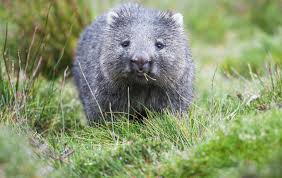
Ok, so of course wombats aren’t specific to Tasmania but there are just so many there that they deserve a mention. You can see these guys pretty reliably in Tassie, especially around Cradle Mountain where their furry coats seem thicker to handle the cold, alpine conditions.
Wombats are the world’s largest burrowing herbivorous mammal. Being about 1 meter long and weighing up to 35kg, they are stocky little balls of muscle that could bowl you over if they ran at you at speed. And although they may look like pudgy little waddlers, wombats can actually run at a speed of around 40km/h for a minute and a half. Not bad for a stocky little creature.
They love to dig burrows with their sharp claws and barrel like bodies and create incredible systems of underground tunnels. Because of their digging ability, the wombat’s pouch has actually evolved to face backwards so that they don’t fill up with dirt from digging the burrows.
Of course you’ll always know that you’re in wombat country if you see their distinctive wombat poo. Why? Because it’s square. Wombats mark their territories by leaving their poo lying around, and the shape of it means it doesn’t roll away. Special bones in their bum allow them to squeeze and form their faeces into cubes. The adult wombat produces between 80 to 100, two-centimetre pieces of poo in a single night, and four to eight pieces each bowel movement.
Wombats have proved to be great survivors of the feral species invasion of Australia, as they are very hard to be hunted as prey. If a wombat feels threatened, it dives headfirst into a tunnel, blocking the entrance with its super tough rump. This sturdy rump, and lack of a significant tail, make it difficult for a predator to grab on.
Luckily, there are still many wombats roaming around Tasmania, which make it one of the best places in Australia to see the most loveable creatures.
So there you have it. Just a few of the special creatures that inhabit the paradise that is Tasmania. If you haven’t been, now’s the time to go. Who knows how long these unique animals will be around for us to witness their beauty and survival in the wild.
– Adam IO Guide



